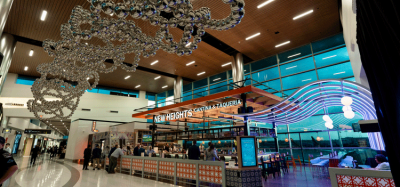Product Showcase: The rise of self-service
- Like
- Digg
- Del
- Tumblr
- VKontakte
- Buffer
- Love This
- Odnoklassniki
- Meneame
- Blogger
- Amazon
- Yahoo Mail
- Gmail
- AOL
- Newsvine
- HackerNews
- Evernote
- MySpace
- Mail.ru
- Viadeo
- Line
- Comments
- Yummly
- SMS
- Viber
- Telegram
- Subscribe
- Skype
- Facebook Messenger
- Kakao
- LiveJournal
- Yammer
- Edgar
- Fintel
- Mix
- Instapaper
- Copy Link
Posted: 16 January 2019 | Alex Wuchte | No comments yet
Alex Wuchte, responsible for the airport baggage handling business development for Jervis B. Webb Company of Daifuku Airport Technologies, discusses the BAGgate self-service bag drop and how the technology is revolutionising the industry.
What is revolutionary about BAGgate?
The major advantage of BAGgate is to enable a passenger to check-in baggage without the assistance of a ticket agent. This ultimately means that fewer ticket agents will be required to check-in passengers. In the past, it has been a 1:1 ratio of passengers to ticket agents that are able to check-in bags. Now, with self-service stations, a single ticket agent can assist with multiple self-service BAGgate stations. This increases the efficiency of the bag check process and improves passenger throughput for the airline and airport as well as reducing the number of ticket agents required for the bag check process.
Why is it important for airports to utilise self-service technologies?
Self-service technology in general is not new (think supermarket self-checkout), but for the airport sector it is very new. Ticket agents can never be replaced because they handle many complicated tasks other than just checking in bags. So, if we can give this one simple, yet time-consuming, task to a passenger to perform with a machine, this will allow the agents to focus on the more complicated tasks that they need to perform. This will also yield lower wait times for all passengers and improve customer service. If other industries are any indication of the success that can be had with utilising self-service technology, then airports have a lot to gain by adopting this trend.
How has BAGgate been received in the industry to date?
BAGgate has been incredibly well received since the first model was manufactured and installed in 2007. Since then, Daifuku has installed over 300 BAGgate units in over 20 airports located around the world. Daifuku has developed multiple standardised versions of the BAGgate to fit almost any of our customers’ needs. However, if none of the ‘off-the-shelf’ models fit the space requirements, we are able to provide custom renderings and production of a model that fits the exact needs of the customer.
How has the baggage handling sector evolved with the advent of new technologies and where do you see the future of this segment of the industry going?
As passenger volume increases year-onyear, airports and airlines are searching for (or already relying on) new and innovative ways to accommodate the increase in passenger volume. The challenge is that while airlines must remain within the precious, limited real estate available at every airport; more passenger throughput is required in the same amount of space. New technologies in the market, such as the Daifuku BAGgate, are providing solutions to many of these challenges. New, innovative products in the marketplace are now enabling an increase in the processing speed of passengers and bags – all within a similar footprint. Our customers have embraced any additional advantage they can gain in already existing spaces.
Issue
Related topics
Airport development, Baggage handling, Passenger experience and seamless travel, Self-service


















